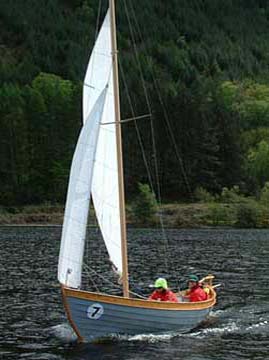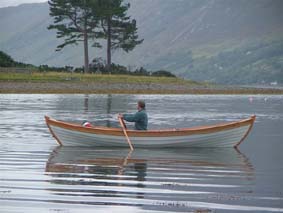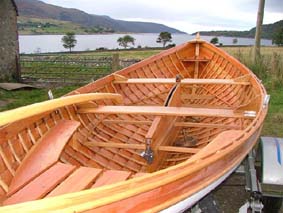| |
THE
NORWEGIAN sjekte and a private commission for a double ended sailing
dinghy inspired this 1934 design by Karsten Ausland. A naval architect,
Ausland emigrated from Norway to work at Nevins boatyard in New
York.
For the 18ft double ender Jan he drew the fine
lines associated with Scandinavia together with the tall racing
rigs of Thirties America. Originally carvel built and with a bronze
centreboard, Jan raced at Marblehead with wins against
LF Herreshoff to her credit.
Felicity John
Ausland’s design had lain dormant for nearly 70 years until
Tim Loftus laid the keel and made the moulds – taken from
a line drawing in Design Quarterly magazine – for Jan’s
successor.
Adrian Morgan then took over the build of the
sjekte and, keen to track down the original plans, set about researching
its history.
He traced Ausland’s grand daughter in the
US who, delighted that Jan would have at least one successor, not
only sold him the plans but also provided photos and information about
Ausland as well as the story of Jan.
|
|
A grand design
Armed with the plans he needed, and Ausland’s design for a
12ft version, Morgan completed her build at his Leckmelm yard.
With the new year came the elegant 22-foot mast
(hollow spruce by Collars of Oxford), sails (North Sea Sails), trailer-making,
varnishing, painting, and her name.
Felicity John (FJ) was launched on Loch Achall,
near Ullapool, in March 2003. She sailed like a witch – a
credit to her designer.
Coast to coast
At Sail Caledonia in June 2003 Morgan sailed – and rowed –
FJ east along the Caledonian Canal from Fort William to Inverness.
The typically variable wind, water and weather
conditions during the week-long event were an ideal test; FJ took
it all in her stride and proved a real joy to sail.
She picked up her first prize, too, on the Loch Oich race, relegating
designer Iain Oughtred in Jeannie II to an unaccustomed second place.
|
|
Florence Oliver
FJ turned heads the length of the canal – most importantly
that of fellow competitor, Ted Phillips, and by the time he reached
the last lock at Inverness Phillips had commissioned a sjekte for
himself and was already thinking about options for alternative rigs
(he chose gunter) and layouts.

|



